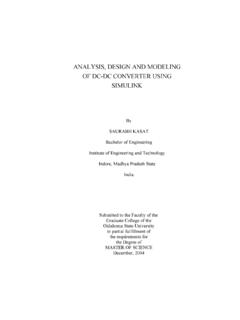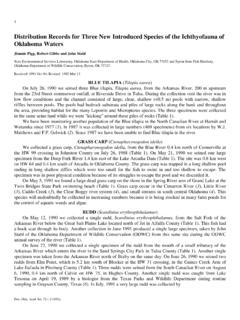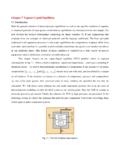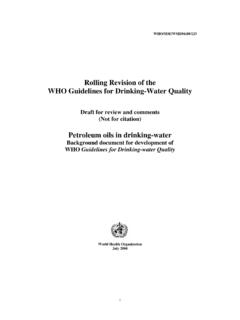Transcription of A Chemical Investigation of Aloe barbadensis Miller
1 69*Journal article 3083, Oklahoma Agricultural Experiment Station, Stillwater, Oklahoma. Present Address: Laboratorio Farmaco-Tossicologico "F. Gorgone", Cyanamid Italia, SpA, XVa Strada Zona Industriale, Catania, Italy. Present Address: Institute of Surgical Research, Brooke Army Medical Center, Fort Sam Houston, Texas 78234 Proc. Okla. Acad. Sci. 58: 69-76 (1978)A Chemical Investigation OF aloe barbadensis Miller *G. R. Waller, S. Mangiafico and C. R. Ritchey Department of Biochemistry, Oklahoma Agricultural Experimental Station, Oklahoma State University, Stillwater, OklahomaFree amino acids, free monosaccharides and total saccharides released upon hydrolysis, sterols, and triterpenoids of theleaves of aloe barbadensis Miller leaves were determined.
2 Some seventeen amino acids, D-glucose, and D-mannose werepresent in the water-soluble fraction. Cholesterol, campesterol, -sitosterol, and lupeol were found in substantial amounts inthe lipid fraction. An unknown(s) alkaloid was detected using Dragendorff's the earliest days of recorded history, man has made use of aloe plants (1, 2, 3). There are severalreferences to aloes in the Bible (4) but since it was then used as a perfume or incense, identification with themodern species of aloe (family Liliaceae), which are not known for their aromatic properties, is doubtful(5). The one used in this study is aloe barbadensis Miller (Figure 1), commonly called aloe vera; the juiceof this plant has an unpleasant odor and taste.
3 This species is native to the Mediterranean region (or to India), but is now widely distributed in southern parts of North America, Europe, and Chinese were among the earliest people who used the plant for its medicinal qualities (6), but itwas considered valuable throughout the Middle Ages for a variety of ills. Even today there is considerableuse of A. barbadensis in folk medicine in the southernmost United States, and some cosmetics and patentmedicines generally found on the market are prepared from the gel in the leaves (Figure 2) and from thejuice. Over a hundred thousand plants have been grown at one time in Florida, Texas, and Mexico formarket, and it has been estimated that annual sales in this country amount to millions of dollars (7).
4 A number of paramedical publications extol its ability to promote the healing of burns and othercutaneous injuries and of ulcers of mucous membranes; this literature has been reviewed by Gjerstad andRiner (7). Many housewives are reported to grow A. barbadensis as a kitchen plant just to provide a hometreatment for minor skin injuries. A preparation made from it has been patented as a topical medication forburns (8).There are contradictory claims on the bacteriostatic activity of aloe leaves and extracts (7, 9), but somefive scientific reports attribute improved healing of burns to their treatment with A.
5 barbadensis products(7). These have also been found effective against peptic ulcers (10), skin disorders (11, 12), and infectionstreated in veterinary medicine (13).Aloes have long been recognized by pharmacopoeias over the world ( , 14, 15) as a purgative drug;one variety, called Curacao aloes, is the dried juice of A. barbadensis . This use of aloes led to studies oftheir composition. In 1956 paper chromatography showed the presence of anthranol (I), aloe -emodin (II),and chrysophanic acid (chrysophanol) (III) (16) (Figure 3). However, when the juice of fresh aloe leaveswas studied in a nitrogen atmosphere, aloin (barbaloin) (IV) and p-coumaric acid (V) but no aloe -emodinwas found (17); presumably the latter was an artifact produced by air oxidation.
6 A commercial sample ofaloes (A. barbadensis ) contained aloesin (VI) (18); in another one the principal constituent was barbaloin,but some free aloe -emodin and isobarbaloin were present (15). A thin-layer chromatographic study of 22species of Aloes (19) showed that 12 species contain flavanoids, hydroxyanthraquinones, and carbohydrates of aloe juice have been reported to be glucose (20) and a polyuronide composed of (a) apolyose (molecular weight up to about 105) containing glucose and mannose and (b) hexuronic acidssuch as glucuronic, mannuronic, and galacturonic acids (8). Later work confirmed that hydrolysis gives glu-71cose and mannose, as well as traces of galactose, arabinose, andxylose, but found no uronic acids (21).
7 The juice is of course mostly water ( ); thelyophilized and dried product contained a variety of functionalgroups as shown by infrared spectroscopy (IR), protein byKjeldahl analysis, free hydroxyproline, histidine, and cystine bythin-layer chromatography (TLC), and after hydrolysis theamino acids shown in Table 1 (20). Bradykininase activity ispresent in aloe arborescens Miller (22), but the existence of anyanti-inflammatory action in vivo remains to be shown. Theeffects of prednisolone, indomethacin and aloe gel on tissueculture cells showed that aloe gel was less toxic to HeLa cells and rabbit kidney cells than prednisolone orindomethacin; however, at a serial dilution of 5 10 1, the aloe gel solution was completely toxic to bothcell lines (23).
8 Thus, as in the case of many other folk medicines, the efficacy of A. barbadensis remains uncertain,and some potentially physiologically active constituents are still unidentified. The present paper reports theoccurrence of free amino acids, free monosaccharides and those produced by hydrolysis, sterols, andtriterpenoids in aloe barbadensis leaves (24).MATERIALS AND METHODSP lant materialAloe barbadensis Miller plants were grown from young plants (obtained from Hilltop Gardens, Lyford,Texas) to maturity in the Oklahoma State University horticultural greenhouse. For positive identification ofthis species of aloe , a specimen in bloom was sent to the Plant Science Research Division of the UnitedStates Department of Agriculture, Beltsville, Maryland, whereit was identified as aloe and fractionationSince there were reports that severed aloe leaves rapidlylose their medicinal properties (6, 9) the material used waseither fresh or lyophilized and stored at 15 C.
9 A. barbadensisleaves (35 g equivalent of dry material) were macerated andextracted with water-acetone (1:1) and then with acetone atroom temperature. The combined extracts (2:1) wereconcentrated in a rotary evaporator (35 C) and the acetone-freeresidue was extracted three times with diethyl ether (250 mleach time). The lipid phase was taken to dryness and theresidue refluxed with 10% potassium hydroxide in 50%ethanol (50 ml) for 3 hr. This hydrolysate was extracted withdiethyl ether and the concentrated organic phase ( g) waschromatographed on a silica gel column ( 35 cm), elutedwith benzene: diethyl ether (8:2), and collected in 10-mlfractions.
10 The resulting 20 fractions were assayed by thin-layerchromatography (TLC) (see chromatography sec-72tion: silica gel, solvent 4, chromogenic reagent b) and recombined to give triterpenoid and sterol aqueous phase (250 ml ) was concentrated under reduced pressure, clarified by centrifugation, andpassed successively through Dowex-50 W (50-100 mesh, 8, H+) ( 35 cm) and Amberlite IRA-400(50-100 mesh, 8, OH ) (4 40 cm) columns. The aqueous eluate was taken to dryness and constituted the"neutral fraction." The "cationic fraction" was obtained by treatment of the cation exchange resin with 2 NNH4OH (2 l ).











